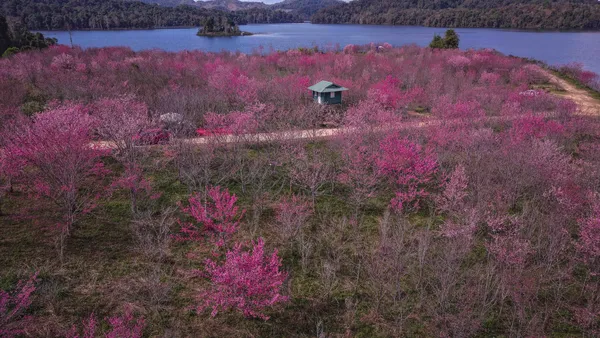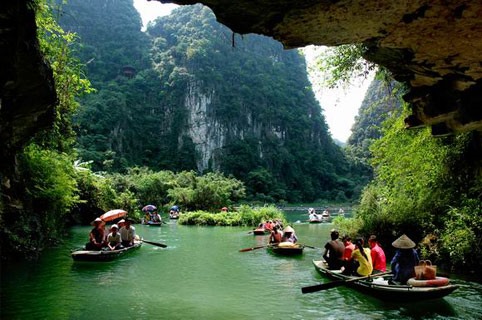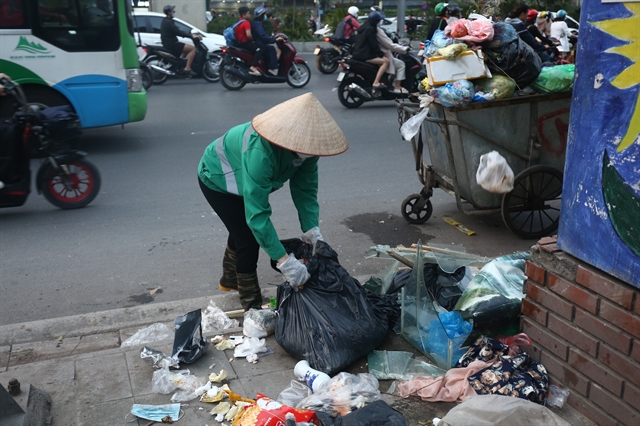 Life & Style
Life & Style

I had heard that the Tràng An complex was one of most attractive natural beauty sites in Việt Nam, but my recent trip there surpassed all expectations.
When we arrived at the site, about 95 kms south of Hà Nội, we took a boat to Suối Tiên Temple.
 |
| Tranquility: Beautiful landscape on the way to Suối Tiên Temple. |
By Hà Nguyễn
I had heard that the Tràng An complex was one of most attractive natural beauty sites in Việt Nam, but my recent trip there surpassed all expectations.
When we arrived at the site, about 95 kms south of Hà Nội, we took a boat to Suối Tiên Temple.
The boatwoman, named Nguyễn Thị Thục, told us that usually each boat only carries five people but when there are many travellers she has to row six.
Some of us were so afraid the boat might sink under our collective weight, but Thục reassured us: "Don’t worry. I have been doing this for 20 years without an accident.” Even so, she handed out orange life vests.
The river ride to Suối Tiên Temple takes an hour. I was impressed by the pure water of Sào Khê River and absence of garbage, giving us a clear view of the fish swimming alongside us and the bottom of the river.
We then rowed through the Nậm and Vang caves, and Thục told us to bend low so as to evoid the overhanging stalactities. The caves were so beautiful that we asked Thục to row slowly so that we could enjoy them.
But the most impressive was the 250m Thánh Trượt Cave.
Asked about the name of the cave, Thục related its story: Hundreds of years ago, King Đinh Tiên Hoàng passed by the cave and suddenly fell. His guards were very worried, but he recovered. The locals named the cave Thánh Trượt , meaning "King’s Fall".
 |
| Clear water: People on Sào Khê River boats to the Suối Tiên Temple. Photos Hà Nguyễn |
Passing through the cave we experienced darkness, outlines of stalactities, stones growing from the bottom of the cave. The cool air was heavenly.
The "decor" inside the caves was complemented by the natural beauty of the lime mountains surrounding the river.
Thục said there are hundreds of valuable herb trees and plants growing in these mountains. Her father often goes there to pick different kinds of herbs to treat ailments such as cough, cold, pains in elderly people’s legs and backs. I asked her about the name of the herbs and she promised to provide them via email.
Thục also explained why the river water was so clear: each rower is personally resposible for ensuring that no waste is thrown out of the boat and are punished or fined if their passengers disobey the instruction. I was very impressed that workers like Thục are responsible for protecting the environment.
After an hour, we arrived at the Suối Tiên Temple built in the Đinh Dynasty (924-997) to worship Thánh Quý Minh Đại Vương, locally known as Thánh (Saint) Cao Sơn.
Legend has it said that Saint Cao Sơn was a water nymph dedicated to protecting and bringing peace to the ancient capital Nam Sơn, now the city of Hoa Lư, during the reign of the 18th Hùng King. When he died, a temple was built to worship him.
But the main temple was built by King Đinh Tiên Hoàng in the 10th century at the Tràng An complex of Hoa Lư, the ancient capital. His temple was upgraded by King Trần Thái Tông in the 13th century.
Thục said a big festival to comemorate the saint is held on the 18th of the third lunar month every year, attended by thousands of pilgrims.
Tống Quang Thình, deputy chairman of Ninh Bình Province, said the festival aims to educate young people about patriotism and protection. “This is a great occasion to wish for national stability and lucrative harvests and prosperity," he said.
Tràng An complex is a World Natural Heritage site and includes Tam Cốc-Bích Động - a series of karst caves and mountain pagodas, the ancient and new Bái Đính Pagodas, and the Hoa Lư ancient capital.
The area, dotted with forests, lime mountains, rivers, lakes and dams, covers 12,252 ha. — VNS




